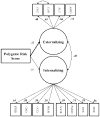Polygenic Risk for Externalizing Psychopathology and Executive Dysfunction in Trauma-Exposed Veterans
- PMID: 27453802
- PMCID: PMC4951156
- DOI: 10.1177/2167702615613310
Polygenic Risk for Externalizing Psychopathology and Executive Dysfunction in Trauma-Exposed Veterans
Abstract
The frequent co-occurrence of antisocial behavior and other disinhibited phenotypes reflects a highly heritable externalizing spectrum. We examined the molecular genetic basis of this spectrum by testing polygenic associations with psychopathology symptoms, impulsive traits, and cognitive functions in two samples of primarily military veterans (n =537, n =194). We also investigated whether polygenic risk for externalizing moderated the effects of trauma on these phenotypes. As hypothesized, polygenic risk positively predicted externalizing psychopathology and negatively predicted performance on inhibitory control tasks. Gene-by-environment effects were also evident, with trauma exposure predicting greater impulsivity and less working memory capacity, but only at high levels of genetic liability. As expected, polygenic risk was not associated with internalizing psychopathology or episodic memory performance. This is the first independent replication of the polygenic score as a measure of genetic predispositions for externalizing and provides preliminary evidence that executive dysfunction is a heritable vulnerability for externalizing psychopathology.
Keywords: genes; impulsivity; inhibitory control; internalizing; veterans; working memory.
Figures



Similar articles
-
Polygenic Score for Smoking is associated with Externalizing Psychopathology and Disinhibited Personality Traits but not Internalizing Psychopathology in Adolescence.Clin Psychol Sci. 2021 Nov 1;9(6):1205-1213. doi: 10.1177/21677026211002117. Epub 2021 May 6. Clin Psychol Sci. 2021. PMID: 35003907 Free PMC article.
-
Polygenic risk for externalizing disorders: Gene-by-development and gene-by-environment effects in adolescents and young adults.Clin Psychol Sci. 2015 Mar;3(2):189-201. doi: 10.1177/2167702614534211. Clin Psychol Sci. 2015. PMID: 25821660 Free PMC article.
-
Correlates of externalizing psychopathology in incarcerated men.Psychol Assess. 2022 Oct;34(10):912-922. doi: 10.1037/pas0001161. Epub 2022 Jul 18. Psychol Assess. 2022. PMID: 35849404 Free PMC article.
-
ERN as a transdiagnostic marker of the internalizing-externalizing spectrum: A dissociable meta-analytic effect.Neurosci Biobehav Rev. 2019 Aug;103:133-149. doi: 10.1016/j.neubiorev.2019.06.013. Epub 2019 Jun 18. Neurosci Biobehav Rev. 2019. PMID: 31220503
-
Child executive function and future externalizing and internalizing problems: A meta-analysis of prospective longitudinal studies.Clin Psychol Rev. 2022 Nov;97:102194. doi: 10.1016/j.cpr.2022.102194. Epub 2022 Aug 8. Clin Psychol Rev. 2022. PMID: 35964337 Review.
Cited by
-
An examination of reciprocal associations between substance use and effortful control across adolescence using a bifactor model of externalizing symptoms.Dev Psychopathol. 2021 Oct;33(4):1507-1519. doi: 10.1017/S0954579420000644. Dev Psychopathol. 2021. PMID: 32662367 Free PMC article.
-
Genetic risk for coronary heart disease alters the influence of Alzheimer's genetic risk on mild cognitive impairment.Neurobiol Aging. 2019 Dec;84:237.e5-237.e12. doi: 10.1016/j.neurobiolaging.2019.06.001. Epub 2019 Jun 8. Neurobiol Aging. 2019. PMID: 31272697 Free PMC article.
-
Conceptualizing traumatic stress and the structure of posttraumatic psychopathology through the lenses of RDoC and HiTOP.Clin Psychol Rev. 2022 Jul;95:102177. doi: 10.1016/j.cpr.2022.102177. Epub 2022 Jun 6. Clin Psychol Rev. 2022. PMID: 35690042 Free PMC article. Review.
-
Cortisol as a Biomarker of Alcohol Use in Combat Veterans: A Literature Review and Framework for Future Research.J Dual Diagn. 2020 Jul-Sep;16(3):322-335. doi: 10.1080/15504263.2020.1771504. Epub 2020 Jun 4. J Dual Diagn. 2020. PMID: 32493131 Free PMC article. Review.
-
Linking genes, circuits, and behavior: network connectivity as a novel endophenotype of externalizing.Psychol Med. 2019 Aug;49(11):1905-1913. doi: 10.1017/S0033291718002672. Epub 2018 Sep 12. Psychol Med. 2019. PMID: 30207258 Free PMC article.
References
-
- Babinski LM, Hartsough CS, Lambert NM. Childhood conduct problems, hyperactivity-impulsivity, and inattention as predictors of adult criminal activity. Journal of Child Psychology and Psychiatry. 1999;40(03):347–355. http://dx.doi.org/ - PubMed
-
- Barkley RA. Behavioral inhibition, sustained attention, and executive functions: constructing a unifying theory of ADHD. Psychological Bulletin. 1997;121(1):65–94. http://dx.doi.org/10.1037/0033-2909.121.1.65. - DOI - PubMed
Grants and funding
LinkOut - more resources
Full Text Sources
Other Literature Sources
Research Materials
